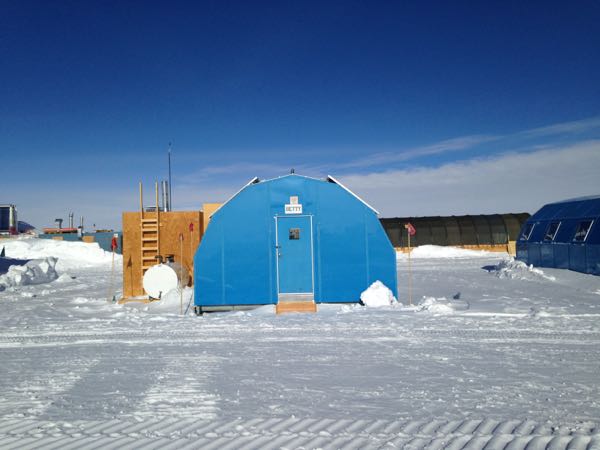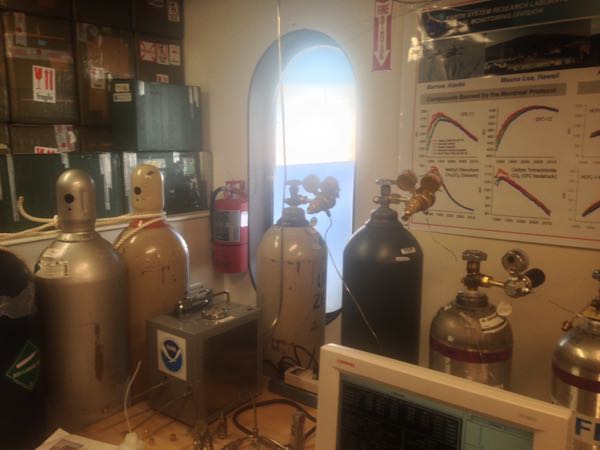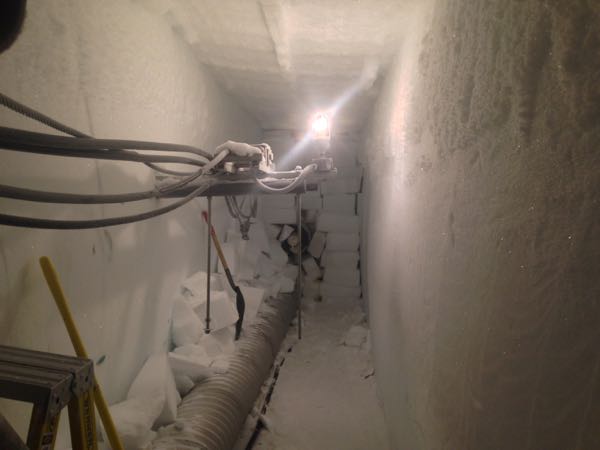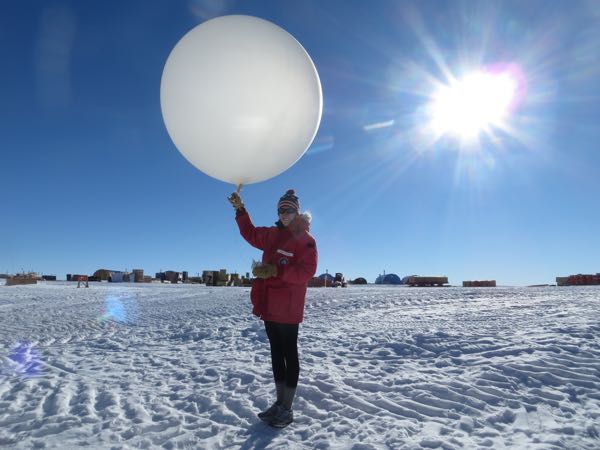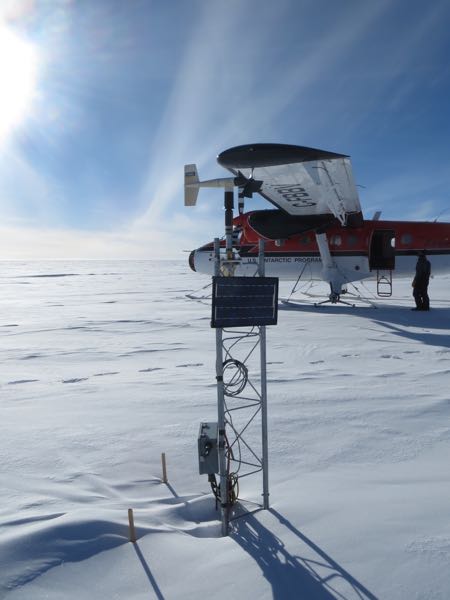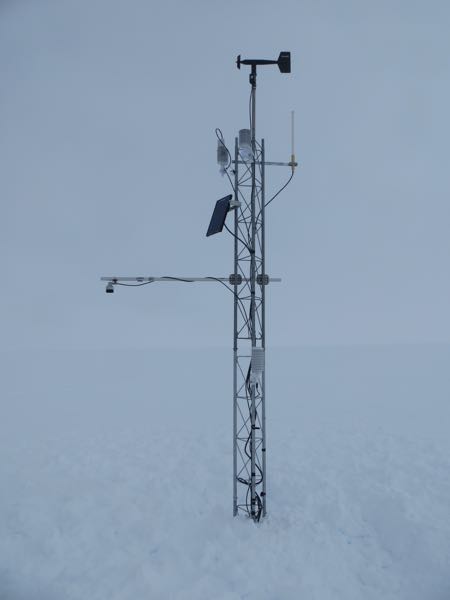Hello Again!
Dave and I got back from the South Pole on Saturday, January 17th after completing AWS visits at both Nico and Henry. This post will talk about a couple of things we did while we waited nine days for our flight and then what happened at the Nico visit. Dave will talk about some other activities at Pole and the Henry visit.
We arrived at South Pole late on Monday, January 5th. Dave and I almost immediately felt how cold it was and quickly learned we would be experiencing a lot of shortness of breath. After a quick briefing we learned that we would not be staying in the South Pole station because the population was too high. Instead, we would be staying about a quater of a mile from the station in the “hypertats”. The hypertat was heated to normal temperatures (65F to 70F), and in all honestly it wasn’t too bad! The worst part was that there was no running water, so you either had to use the outhouse or walk back to the station which was about a five minute walk.
The first couple of days we knew we wouldn’t be flying to any AWS because we would be acclimating to the altitude (~9,300 ft) and organizing all of the gear. We also quickly learned that we were missing a couple essential items; channel locks, fuses, and shovels. We got the channel locks from the Vehicle Maintenance Facility (VMF) and found 4 shovels in the shed at the cargo yard. The most difficult item to find was the fuses, it took us a whole day to figure out that we needed car fuses, and luckily the VMF had just what we needed!
After our first 2-3 days at South Pole we had found everything we needed and we were pretty well acclimated to the high altitude. Then it was time to wait for the Twin Otter plane to be available. We knew that it was likely going to be a long wait since a couple of camps near the South Pole needed to be pulled out. In the mean time, we were able to visit a lot of science that was going on at South Pole.
One of my favorite visits was to the Atmospheric Research Observatory (ARO). They take real-time carbon dioxide measurements, launch ozone balloons, and track the ozone hole during the springtime. We learned all about the history of ozone hole, and about some of instrumentation they use for their atmospheric operations. They claim to have “The Cleanest Air in the World” thanks to a clean air sector that extends from 340 to 110 degrees longitude for 80 miles. In theory, our AWS were within the clean air sector. We warned them we would be flying through it, so they understood.
After a great tour by Andy, we were given glass tubes to do our own collection of “The Cleanest Air in the World”. As we were leaving we saw all of the tanks of air samples they have been collecting all season long.
In the mean time, we played a lot of games of cribbage in many of the different hangout rooms at the station. There was the dining room, the lounge, the greenhouse (where they grow food to eat!), and the game room. The game room had this awesome cribbage board that had Antarctica carved in it. We probably played about 10 to 20 games on that board!
One evening we were given a tour from “Mike the Plumber” to see the snow tunnels underground that carry the water and sewage to and from the station. These tunnels were very tight and the temperature under the snow was about -50F. All of our eyelashes froze, but we didn’t get too cold! Along the way there are a bunch of shrines craved into the walls of the snow. There are busts of Amundsen, dead fish, glycol, food, alcohol, and at the end My Little Pony!
One last event we participated in was another weather balloon launch. I hadn’t done a balloon launch in McMurdo yet, so I got to do one at the South Pole. We joined the meteorologist Jeremiah for the launch and he showed us how to calibrate the instrument. Then we each wrote messages on the package that is attached to the balloon and then I sent it up in the air!
We visited a lot of other science that Dave will talk about in the next post!
Then it was finally our chance to use the Twin Otter plane and head to our first sight Nico. After nine days of waiting around we were definitely ready to get out in the field. Lucky for us, we were able to take two people with us to help dig out the stations and add all of the new instrumentation. For the first visit we got help from Darrin from the VMF and Grant from Spice Core who actually works for IDDO at SSEC. He works three floors above our office in Wisconsin and we had to travel all the way to the South Pole to meet him.
We left about 8:35am and headed about 60 miles grid east to Nico AWS. The weather was close to whiteout conditions on the way, but the pilots figured that conditions might get better. When we arrived at the sight it was about five to six feet tall and it was not too bad outside. We figured we wouldn’t need to do too much digging to get down to the enclosure and the battery box.
It turns out we needed to dig down about five or six feet to get to the enclosure and then we decided it would be too difficult to try and recover the battery, so they were left at the site. It took about an two hours to get all of the instrumentation off and install the battery box. Then we added another seven foot tower section and began to put on all of the instruments.
Then it was time for the tough part. Being at the South Pole is a new kind of beast that both Dave and I hadn’t experienced. At that point we needed to start climbing the tower and adding the areovane, two temperature sensors (one with an aspirated shield), ADG, Argos transmitter, solar panel and relative humidity sensor. While Dave and I were on the tower we asked our helpers to attached the enclosure and the relative humidity sensors since that wasn’t too high. Dave and I struggled to keep our hands warm in the -20F temperatures with a -40F wind chill. I had to go into the plane once to try and warm up my hands. After about a five minute warm up I got back on the tower to help get the last few instruments installed. At that point we noticed that Henry (our pilot) was building a runway with snow piles. The weather had turned pretty quickly and it started to snow with near whiteout conditions. Dave finished plugging everything in quickly and we tried to check if it was transmitting properly but the Teleonics wasn’t working and we needed to head back. Dillan (our co-pilot) warned us of the possibility of having to camp out.
In the end we packed up the plane and the site visit took about five hours. For all of the work we did and being in those intense conditions, we considered that pretty fast. We managed to make the tower about thirteen or fourteen feet tall and got both the battery box and enclosure buried under the snow surface. Near the South Pole, it’s considered better to bury electronics since they will experience consistent temperatures of about -50F versus the ambient temperature can get as low as -100F in the winter. Sorry we don’t have more pictures, but it’s very difficult in those temperatures to take pictures and there wasn’t much time for breaks 🙂
In the next blog post Dave will have more photos of the Henry visit because one of the diggers that came with us took a lot of pictures while we were working!
I made another blog post of some of random things we did at South Pole!
Enjoy!
Carol


